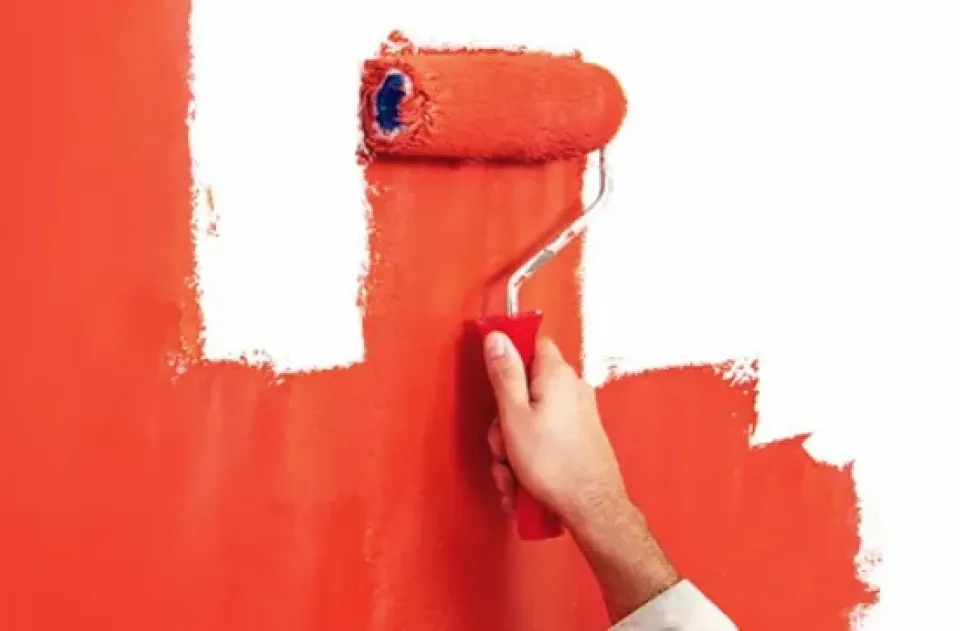
Painting walls
How to paint walls correctly
1. Selection of finishing materials for walls (wallpaper, decorative plaster, cladding, painting)

Today, the market of finishing materials offers many options for finishing walls indoors. The main finishing materials are wallpaper, decorative plaster, facing and painting. The lightest and most practical material for finishing is paint. Why is that?! Now we will understand.
Unlike wallpaper, paint creates an antistatic effect, due to which dust does not linger on the surface, the painted surface becomes resistant to mechanical stress (pet claws, impacts, mold), the paint is resistant to washing and abrasion, more durable, joints are not visible on the painted surface. Changing the color of the interior or repainting repairs will not cause much trouble, unlike changing the wallpaper.
Compared to decorative plaster, the cost of paint is much lower, and you can paint it yourself, but to apply decorative plaster you need to involve an experienced craftsman. In addition, the paint is in no way inferior, and in some cases even surpasses, decorative plaster in terms of wear resistance and aesthetics.
Today, there are special paints for swimming pools, for bathrooms, which are not inferior in strength and water-repellent properties to ceramic tiles. The cost of the paint is several times lower, and the painting process is much faster.
2. Selection of paints for different types of rooms (degree of gloss, resistance to washing)
A wide selection of paints allows you to find a painting solution for any room. Rooms in the house can be divided into several types, for example, rooms with normal humidity (bedrooms, children's rooms, living rooms) and rooms with high humidity (bathroom, kitchen, hallway, toilet).
In rooms with normal humidity, matte paints that are resistant to wet cleaning are most often used. In rooms with high humidity, gloss paints from silk-matt (resembling fabric, silk) to semi-matt or semi-gloss (paints with a fairly pronounced shine) are most often used. Gloss paints have very high resistance to abrasion, they can be washed with a detergent (neutral pH 8-9), and some of them can withstand washing with disinfectants. But it should be taken into account that gloss paints can emphasize surface defects, while matte paints, on the contrary, visually hide such defects. There are also completely matt paints that have the highest resistance to abrasion. Surfaces painted with such paints can also be washed with a neutral (pH 8-9) detergent..
3. Tools for preparation and painting

The following tools may be needed for surface preparation and painting:
- 1. Ladder.
- 2. Spatulas.
- 3. Wide and narrow brushes.
- 4. Covering film.
- 5. Roller handle and replacement rollers (new rollers must be washed to remove loose lint).
- 6. Paint bucket.
- 7. Paint tape.
- 8. Telescopic handle (extension).
- 9. Drill.
- 10. Paint mixer.
- 11. Sandpaper.
- 12. Paint bucket.
- 13. Rag.
- 14. Scraper.
- 15. Maklovitsa (wide brush for priming).
4. Surface preparation for painting

The process of preparing the surface before painting takes at least 75% of the time allocated for repair work.
The main requirement for the painted surface is that the surface must be strong, not covered with dust and must not contain greasy or oily contaminants. The process of preparing the surface for painting can be divided into several stages.
- 1. Removing the old coating or parts of the plaster that are not firmly attached. If the coating is strong, it must be degreased and washed with clean water.
- 2. Priming before applying the putty. The primer will bind the dust on the surface, strengthen the base, and improve adhesion.
- 3. Puttying. Leveling cracks, potholes, and coating defects.
- 4. Sanding the putty. Sanding will make the surface as even and smooth as possible.
- 5. Priming. This priming is necessary to remove dust after sanding.
- 6. Painting. Before painting the walls, it is necessary to use masking tape to cover all elements that will not be painted (window sills, moldings, baseboards, window frames, radiators; we also tape over sockets and switches with masking tape, having previously removed the covers from them), and also cover the floor with foil. Before painting, all furniture must be removed from the room.
Attention!!!! Before removing the covers from the sockets and switches, be sure to turn off the electricity.
5. Features of painting
The optimum temperature for applying water-based paints is +18...+22°C. A higher temperature leads to rapid drying of the paint on the surface, as a result of which stripes (joints and transitions) will appear on the painted surface. Drafts also accelerate drying. Therefore, to eliminate the possibility of drafts, windows and doors must be closed before painting with water-based paints.
Before starting painting, the paint must be mixed with a drill and poured into a bucket. For painting, it is better to use a natural sheepskin roller with a pile length of 12 to 16 millimeters. Depending on the area of the room, you can use a roller 180 or 250 millimeters long.
First, using a brush (synthetic or mixed bristle) or a small roller (length 100 mm), you need to paint the corners, paint (draw) straight lines near ceiling moldings, baseboards, sockets, switches. After that, you can proceed to painting the main part of the wall. The roller (180-250 mm) must be moistened with clean water, then dipped in paint and rolled out thoroughly on a tray. The paint is applied to the wall in two layers with mandatory drying between layers from 1 to 3-4 hours. When applying paint, the roller must move from the bottom up to avoid the formation of streaks and drops.
The paint is applied to the wall parallel to the main light source - the window. When applying paint, you only need to join one strip to another wet on wet, that is, constantly keep the edge wet. The entire wall must be painted without interruption from corner to corner. The roller can be wrapped in plastic wrap between layers to prevent the paint from drying on it.
6. Caring for the painted surface

For 3-4 weeks after painting, the surface must be handled with care, because during this period the paint gains its strength and wear resistance. For cleaning, clean water or a non-abrasive detergent (neutral pH 8-9) should be used. In addition, to avoid the formation of streaks, smears and stains (glossiness), when washing the painted surface, it is necessary to wash not only the specific place of contamination, but also the entire wall from corner to corner.







